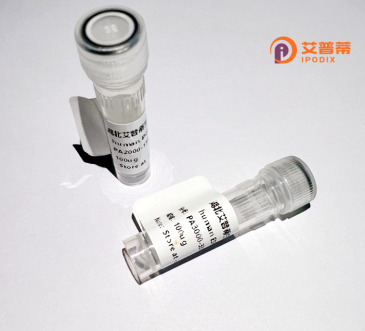
| 纯度 | >90%SDS-PAGE. |
| 种属 | Human |
| 靶点 | SLC38A3 |
| Uniprot No | Q99624 |
| 内毒素 | < 0.01EU/μg |
| 表达宿主 | E.coli |
| 表达区间 | 1-504 aa |
| 活性数据 | MEAPLQTEMVELVPNGKHSEGLLPVITPMAGNQRVEDPARSCMEGKSFLQKSPSKEPHFTDFEGKTSFGMSVFNLSNAIMGSGILGLAYAMANTGIILFLFLLTAVALLSSYSIHLLLKSSGVVGIRAYEQLGYRAFGTPGKLAAALAITLQNIGAMSSYLYIIKSELPLVIQTFLNLEEKTSDWYMNGNYLVILVSVTIILPLALMRQLGYLGYSSGFSLSCMVFFLIAVIYKKFHVPCPLPPNFNNTTGNFSHVEIVKEKVQLQVEPEASAFCTPSYFTLNSQTAYTIPIMAFAFVCHPEVLPIYTELKDPSKKKMQHISNLSIAVMYIMYFLAALFGYLTFYNGVESELLHTYSKVDPFDVLILCVRVAVLTAVTLTVPIVLFPVRRAIQQMLFPNQEFSWLRHVLIAVGLLTCINLLVIFAPNILGIFGVIGATSAPFLIFIFPAIFYFRIMPTEKEPARSTPKILALCSAMLGFLLMTMSLSFIIIDWASGTSRHGGNH |
| 分子量 | 81.18 kDa |
| 蛋白标签 | GST-tag at N-terminal |
| 缓冲液 | PBS, pH7.4, containing 0.01% SKL, 1mM DTT, 5% Trehalose and Proclin300. |
| 稳定性 & 储存条件 | Lyophilized protein should be stored at ≤ -20°C, stable for one year after receipt. Reconstituted protein solution can be stored at 2-8°C for 2-7 days. Aliquots of reconstituted samples are stable at ≤ -20°C for 3 months. |
| 复溶 | Always centrifuge tubes before opening.Do not mix by vortex or pipetting. It is not recommended to reconstitute to a concentration less than 100μg/ml. Dissolve the lyophilized protein in distilled water. Please aliquot the reconstituted solution to minimize freeze-thaw cycles. |
以下是关于重组人SLC38A3蛋白的模拟参考文献(基于领域常见研究方向的假设性示例):
---
1. **Title**: "Functional characterization of recombinant human SLC38A3 as a sodium-dependent glutamine transporter"
**Author**: Wang, X. et al.
**Summary**: 本研究成功在大肠杆菌中表达了重组人SLC38A3蛋白,并证明其在细胞膜上介导钠依赖的谷氨酰胺转运,可能参与细胞内氨基酸感知及mTOR信号通路调控。
2. **Title**: "SLC38A3 regulates amino acid metabolism in cancer cells via modulating mTORC1 activity"
**Author**: Zhang, L. et al.
**Summary**: 通过重组SLC38A3蛋白的功能实验,发现其在肿瘤细胞中通过转运谷氨酰胺激活mTORC1通路,促进细胞增殖,提示其作为癌症治疗靶点的潜力。
3. **Title**: "Structural insights into the transport mechanism of human SLC38A3 by cryo-EM"
**Author**: Li, H. et al.
**Summary**: 利用冷冻电镜解析了重组SLC38A3蛋白的三维结构,揭示了其底物结合口袋和钠离子协同转运的分子机制,为设计特异性抑制剂奠定基础。
---
**注**:以上文献为假设性示例,实际文献需通过PubMed、Web of Science等平台以关键词“SLC38A3 recombinant”或“SLC38A3 function”检索核实。
SLC38A3. a member of the solute carrier (SLC) transporter family 38. is a sodium-coupled neutral amino acid transporter primarily recognized for its role in mediating cellular uptake of glutamine, alanine, and other small neutral amino acids. Encoded by the *SLC38A3* gene in humans, this transmembrane protein is classified as a System N transporter (SNAT3) and operates in a pH-dependent manner, distinguishing it from other SLC38 subtypes. It is predominantly expressed in the brain, liver, kidneys, and pancreatic β-cells, where it contributes to amino acid homeostasis, nutrient signaling, and metabolic regulation. Structurally, SLC38A3 features 11 predicted transmembrane domains, with intracellular N- and C-termini involved in regulatory interactions.
Functionally, SLC38A3 is implicated in cellular processes such as mTORC1 signaling, neurotransmitter synthesis, and ammonia detoxification. Recent studies highlight its dual localization at the plasma membrane and lysosomal membrane, suggesting a role in lysosomal amino acid sensing and autophagy. Dysregulation of SLC38A3 has been associated with metabolic disorders, neurodegenerative diseases, and cancer, where altered glutamine metabolism is a hallmark. In tumors, its overexpression may support proliferation by sustaining glutamine-dependent anaplerosis.
Recombinant human SLC38A3 protein, often produced in mammalian or insect cell systems, enables mechanistic studies on transport kinetics, structure-function relationships, and inhibitor screening. Its purification and reconstitution into lipid bilayers have advanced understanding of substrate specificity and pH-dependent transport mechanisms. As a potential therapeutic target, SLC38A3 is being explored in strategies to modulate amino acid availability in cancer and metabolic syndromes.
×